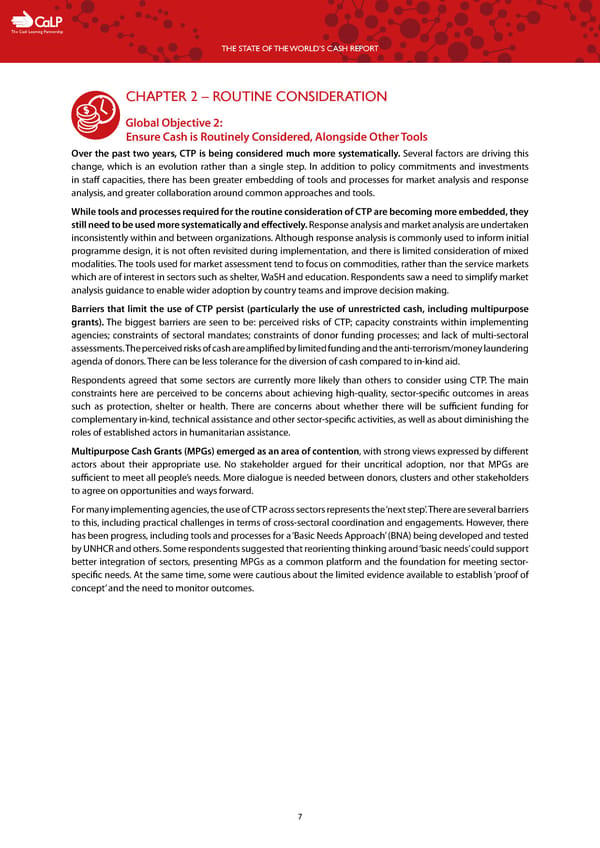C The Cash Learning Partnership THE STATE OF THE WORLD’S CASH REPORT CHAPTER 2 – ROUTINE CONSIDERATION Global Objective 2: Ensure Cash is Routinely Considered, Alongside Other Tools Over the past two years, CTP is being considered much more systematically. Several factors are driving this change, which is an evolution rather than a single step. In addition to policy commitments and investments in staff capacities, there has been greater embedding of tools and processes for market analysis and response analysis, and greater collaboration around common approaches and tools. While tools and processes required for the routine consideration of CTP are becoming more embedded, they still need to be used more systematically and effectively. Response analysis and market analysis are undertaken inconsistently within and between organizations. Although response analysis is commonly used to inform initial programme design, it is not often revisited during implementation, and there is limited consideration of mixed modalities. The tools used for market assessment tend to focus on commodities, rather than the service markets which are of interest in sectors such as shelter, WaSH and education. Respondents saw a need to simplify market analysis guidance to enable wider adoption by country teams and improve decision making. Barriers that limit the use of CTP persist (particularly the use of unrestricted cash, including multipurpose grants). The biggest barriers are seen to be: perceived risks of CTP; capacity constraints within implementing agencies; constraints of sectoral mandates; constraints of donor funding processes; and lack of multi-sectoral assessments. The perceived risks of cash are amplified by limited funding and the anti-terrorism/money laundering agenda of donors. There can be less tolerance for the diversion of cash compared to in-kind aid. Respondents agreed that some sectors are currently more likely than others to consider using CTP. The main constraints here are perceived to be concerns about achieving high-quality, sector-specific outcomes in areas such as protection, shelter or health. There are concerns about whether there will be sufficient funding for complementary in-kind, technical assistance and other sector-specific activities, as well as about diminishing the roles of established actors in humanitarian assistance. Multipurpose Cash Grants (MPGs) emerged as an area of contention, with strong views expressed by different actors about their appropriate use. No stakeholder argued for their uncritical adoption, nor that MPGs are sufficient to meet all people’s needs. More dialogue is needed between donors, clusters and other stakeholders to agree on opportunities and ways forward. For many implementing agencies, the use of CTP across sectors represents the ‘next step’. There are several barriers to this, including practical challenges in terms of cross-sectoral coordination and engagements. However, there has been progress, including tools and processes for a ‘Basic Needs Approach’ (BNA) being developed and tested by UNHCR and others. Some respondents suggested that reorienting thinking around ‘basic needs’ could support better integration of sectors, presenting MPGs as a common platform and the foundation for meeting sector- specific needs. At the same time, some were cautious about the limited evidence available to establish ‘proof of concept’ and the need to monitor outcomes. 7
 The State of the World's Cash | Full Report Page 8 Page 10
The State of the World's Cash | Full Report Page 8 Page 10